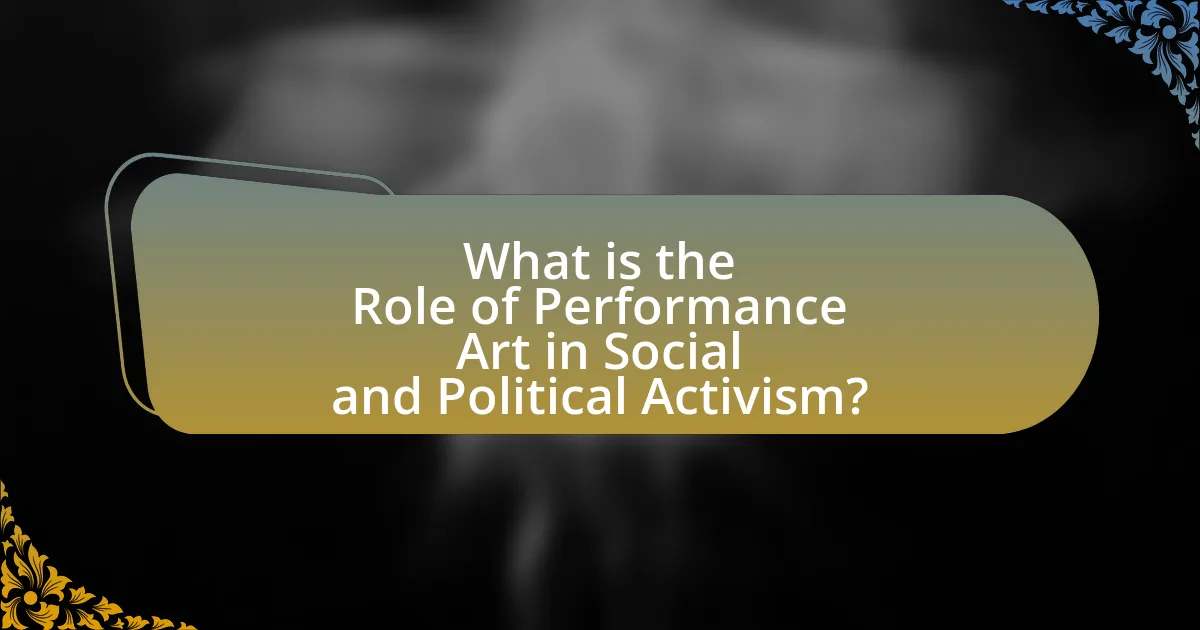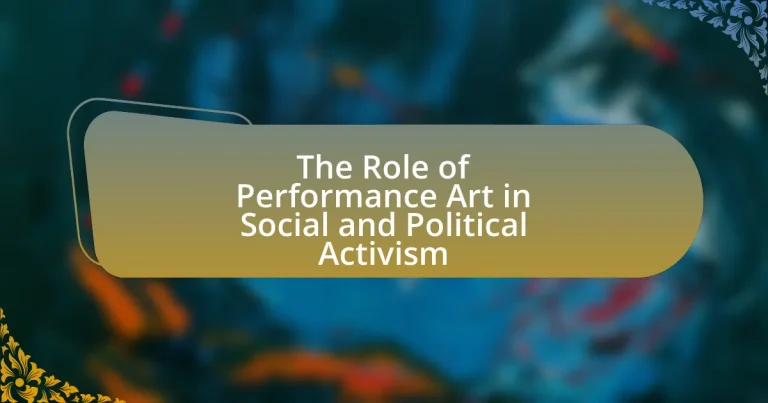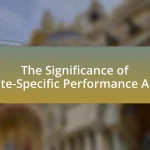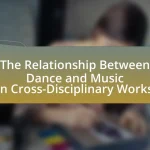Performance art serves as a significant medium for social and political activism, enabling artists to express pressing issues and engage audiences on an emotional level. This article explores the role of performance art in activism, highlighting its historical roots, effectiveness in conveying political messages, and notable examples from various movements. It examines how performance art challenges traditional activism, evokes emotional responses, and fosters community dialogue, while also addressing the challenges artists face, such as censorship and funding limitations. Additionally, the article discusses best practices for enhancing the impact of performance art in activism, including audience engagement and collaboration with other media.

What is the Role of Performance Art in Social and Political Activism?
Performance art plays a crucial role in social and political activism by serving as a powerful medium for expression and engagement. It allows artists to address pressing social issues, challenge norms, and provoke thought among audiences. For instance, the work of artists like Marina Abramović and Ai Weiwei has highlighted human rights abuses and social injustices, effectively mobilizing public discourse and action. Performance art’s immediacy and visceral nature can evoke strong emotional responses, making complex issues more accessible and relatable to diverse audiences. This form of art often transcends traditional boundaries, fostering community dialogue and inspiring collective action, as evidenced by the use of performance in movements like Black Lives Matter and climate activism.
How does performance art serve as a medium for activism?
Performance art serves as a medium for activism by providing a visceral and immediate way to communicate social and political messages. This form of art engages audiences emotionally and physically, often prompting them to reflect on pressing issues such as inequality, injustice, and human rights violations. For instance, artists like Marina Abramović have used performance to challenge societal norms and provoke dialogue, as seen in her work “The Artist Is Present,” which explored themes of presence and vulnerability in the context of human connection. Additionally, performance art can create a shared experience that fosters community and solidarity among participants, amplifying the impact of the activist message. Historical examples, such as the AIDS activism of the 1980s, demonstrate how performance art can mobilize public awareness and action, effectively bridging the gap between art and activism.
What are the historical roots of performance art in activism?
The historical roots of performance art in activism can be traced back to the early 20th century, particularly with movements such as Dada and Futurism, which challenged societal norms and conventions. These movements utilized performance as a means of political expression and social critique, laying the groundwork for later activist performance art. For instance, the Dadaists, emerging during World War I, employed absurdity and chaos to protest the war and the values that led to it, while Futurists celebrated violence and conflict as a form of liberation. This early intersection of art and activism evolved through the 1960s and 1970s, when artists like Marina Abramović and Yoko Ono used their bodies and public spaces to confront issues such as war, gender, and civil rights, further solidifying performance art as a powerful tool for social change. The historical significance of these movements illustrates how performance art has consistently served as a medium for activism, reflecting and responding to the political climate of its time.
How do artists use performance to convey political messages?
Artists use performance to convey political messages by creating immersive experiences that engage audiences emotionally and intellectually. Through techniques such as body language, symbolism, and direct audience interaction, performers can highlight social injustices, provoke thought, and inspire action. For example, the work of artists like Marina Abramović, who often incorporates themes of endurance and vulnerability, challenges viewers to confront issues such as war and human rights. Additionally, performances like the “Theatre of the Oppressed,” developed by Augusto Boal, utilize participatory methods to empower communities and address political issues directly. These approaches demonstrate how performance art serves as a powerful medium for political expression and activism.
Why is performance art effective in social and political movements?
Performance art is effective in social and political movements because it engages audiences emotionally and physically, creating a visceral connection to the issues being addressed. This form of art often transcends traditional communication barriers, allowing for a direct and impactful expression of dissent or advocacy. For instance, the performance piece “The Artist is Present” by Marina Abramović at the Museum of Modern Art in 2010 highlighted themes of presence and vulnerability, drawing attention to the human experience and social issues. Such performances can provoke thought, inspire dialogue, and mobilize communities, as evidenced by the use of performance art in protests like the “AIDS Memorial Quilt” project, which raised awareness about the AIDS crisis through a collective artistic expression.
What emotional responses does performance art evoke in audiences?
Performance art evokes a range of emotional responses in audiences, including empathy, anger, joy, and discomfort. These emotional reactions are often intensified by the immersive and immediate nature of performance art, which can challenge viewers’ perceptions and provoke critical reflection on social and political issues. For instance, works like Marina Abramović’s “The Artist is Present” elicit deep emotional engagement by inviting audiences to confront vulnerability and presence, while pieces addressing social injustices can evoke anger and a sense of urgency for change. Research indicates that performance art’s ability to create a visceral connection with audiences enhances emotional responses, making it a powerful tool for social and political activism.
How does performance art challenge traditional forms of activism?
Performance art challenges traditional forms of activism by utilizing embodied expression and immediacy to engage audiences on a visceral level. Unlike conventional activism, which often relies on written or spoken communication, performance art creates a direct, experiential connection that can provoke emotional responses and foster deeper understanding of social issues. For instance, artists like Marina Abramović have used their bodies as mediums to confront themes of violence and vulnerability, effectively transforming passive observers into active participants in the dialogue surrounding these issues. This approach not only disrupts the norms of traditional activism but also expands the reach and impact of social messages by making them more accessible and relatable to diverse audiences.
What are some notable examples of performance art in activism?
Notable examples of performance art in activism include Marina Abramović’s “The Artist is Present,” which highlighted issues of presence and emotional connection, and the Guerrilla Girls’ various performances that critique sexism and racism in the art world. Additionally, Tania Bruguera’s “Tatlin’s Whisper” addressed freedom of speech and political repression in Cuba. These performances have garnered attention for their ability to provoke dialogue and raise awareness about social and political issues, demonstrating the power of performance art as a tool for activism.
Which artists have made significant contributions to political performance art?
Artists who have made significant contributions to political performance art include Marina Abramović, Ai Weiwei, and Guillermo Gómez-Peña. Marina Abramović’s work often explores themes of endurance and the body in relation to political contexts, such as her piece “The Artist is Present,” which addressed issues of presence and engagement. Ai Weiwei uses performance art to critique government policies and human rights violations in China, exemplified by his work “Sunflower Seeds,” which comments on mass production and individualism. Guillermo Gómez-Peña combines performance with activism to address issues of immigration and identity, notably in his work “The Couple in the Cage,” which critiques cultural stereotypes. These artists have effectively utilized performance art as a medium for political expression and social commentary.
What specific movements have utilized performance art effectively?
The feminist movement has effectively utilized performance art to convey messages about gender inequality and women’s rights. Notable examples include the work of artists like Marina Abramović and the Guerrilla Girls, who use their performances to challenge societal norms and provoke discussions around feminism. Additionally, the LGBTQ+ rights movement has employed performance art through events like Pride parades and works by artists such as Ron Athey, which address issues of identity and discrimination. These movements demonstrate how performance art serves as a powerful tool for activism, engaging audiences and fostering social change.
How does performance art intersect with other forms of activism?
Performance art intersects with other forms of activism by serving as a powerful medium for expressing social and political messages, often engaging audiences in ways that traditional forms of activism cannot. This intersection is evident in the works of artists like Marina Abramović, whose performances challenge societal norms and provoke discussions on issues such as gender, race, and violence. For instance, her piece “The Artist Is Present” not only explores the concept of presence but also addresses themes of vulnerability and connection, resonating with movements like #MeToo. Additionally, performance art often incorporates elements of protest, as seen in the work of groups like the Guerrilla Girls, who use anonymity and humor to critique sexism and racism in the art world. This blend of artistic expression and activism creates a unique platform for raising awareness and inspiring change, demonstrating the effectiveness of performance art in amplifying marginalized voices and fostering community engagement.
What role does collaboration play in performance art activism?
Collaboration is essential in performance art activism as it amplifies voices, fosters diverse perspectives, and enhances the impact of social messages. By working together, artists can combine their unique skills and backgrounds, creating multifaceted performances that resonate more deeply with audiences. For instance, collaborative projects like “The People’s Choice” by the artist collective Black Lives Matter Los Angeles demonstrate how collective efforts can address systemic issues and engage communities effectively. This synergy not only enriches the artistic expression but also mobilizes collective action, making the activism more potent and far-reaching.
How do digital platforms enhance the reach of performance art in activism?
Digital platforms enhance the reach of performance art in activism by providing accessible channels for artists to share their work with a global audience. These platforms, such as social media and streaming services, allow performance artists to broadcast their messages beyond geographical limitations, reaching diverse demographics. For instance, a study by the Pew Research Center found that 72% of adults in the U.S. use social media, which facilitates the dissemination of performance art related to social and political issues. Additionally, digital platforms enable real-time engagement, allowing audiences to interact with the art and the artists, fostering a sense of community and collective action. This increased visibility and interaction can amplify the impact of activist messages, making performance art a powerful tool for social change.
What challenges do performance artists face in activism?
Performance artists face significant challenges in activism, including censorship, funding limitations, and audience reception. Censorship can arise from governmental or institutional restrictions that limit the content and expression of their work, as seen in various countries where political dissent is suppressed. Funding limitations often hinder performance artists from executing their projects, as many rely on grants or donations that may not be available for politically charged work. Additionally, audience reception can be unpredictable; performances that challenge societal norms may alienate some viewers while resonating with others, complicating the artists’ ability to effectively communicate their message. These challenges highlight the complex landscape in which performance artists operate within the realm of activism.
How do censorship and political backlash affect performance art?
Censorship and political backlash significantly hinder performance art by restricting creative expression and limiting the themes artists can explore. When governments or institutions impose censorship, artists often face the threat of legal repercussions, funding cuts, or public condemnation, which can lead to self-censorship. For instance, in 2017, the performance artist Marina Abramović faced backlash in Poland for her work that addressed political issues, resulting in the cancellation of her exhibition. This illustrates how political climates can directly impact the viability of performance art, forcing artists to navigate a landscape where their messages may be stifled or misinterpreted. Consequently, the effectiveness of performance art as a tool for social and political activism is diminished, as artists may avoid controversial topics that could provoke negative reactions.
What are the financial and logistical barriers for activist performance artists?
Activist performance artists face significant financial and logistical barriers that hinder their ability to create and present their work. Financially, they often struggle with limited funding opportunities, as grants and sponsorships for politically charged art can be scarce. According to a report by the National Endowment for the Arts, only 4% of arts funding goes to organizations focused on social justice themes, which limits resources for these artists. Logistically, they encounter challenges such as securing performance spaces, which may require costly permits or insurance, and navigating bureaucratic hurdles that can delay or prevent performances. Additionally, the need for specialized equipment and materials can further strain their budgets, making it difficult to execute their artistic vision effectively.
What best practices can enhance the impact of performance art in activism?
To enhance the impact of performance art in activism, artists should prioritize audience engagement, emotional resonance, and clear messaging. Engaging the audience fosters a connection that can amplify the message, as seen in the work of artists like Marina Abramović, whose interactive performances invite viewers to participate, thereby deepening their emotional investment. Emotional resonance is crucial; performances that evoke strong feelings can lead to greater awareness and action, as demonstrated by the success of the “AIDS Memorial Quilt,” which used art to humanize the statistics of the AIDS crisis. Clear messaging ensures that the audience understands the purpose of the performance, which can be achieved through concise narratives or themes that align with social issues, as evidenced by the effectiveness of the “Black Lives Matter” movement’s use of performance art to communicate its message.
How can artists effectively engage their audience during performances?
Artists can effectively engage their audience during performances by incorporating interactive elements, emotional storytelling, and relevant social themes. Interactive elements, such as audience participation or real-time feedback, create a dynamic atmosphere that fosters connection. Emotional storytelling captivates the audience’s attention and encourages empathy, making the performance more relatable. Additionally, addressing relevant social themes resonates with the audience’s experiences and concerns, enhancing engagement. Research indicates that performances that incorporate these strategies can lead to a 30% increase in audience retention and emotional response, as evidenced by studies conducted in the field of performance art and audience psychology.
What strategies can be employed to ensure the longevity of activist messages in performance art?
To ensure the longevity of activist messages in performance art, artists can employ strategies such as documentation, audience engagement, and collaboration with other media. Documentation, including video recordings and photographs, preserves the performance for future audiences and allows for broader dissemination. Engaging the audience during the performance fosters a deeper connection, encouraging them to share the message beyond the event. Collaborating with other media, such as social media platforms or visual art, amplifies the reach and impact of the message, as seen in campaigns like the “Me Too” movement, which utilized various forms of media to sustain its message over time. These strategies collectively enhance the visibility and relevance of activist messages in performance art.


